The most famous archaeological site of the ancient Maya people in Honduras, Copán, opens for visitors at 8 am and it is indeed a very good thing to come here this early. Despite the vast quantity of greenery and trees that grow on the site, in this way it is possible to avoid the sightseeing of this ancient city in high heat, while the other reason is that there are not too many visitors and crowds at that time.
Copán used to be the capital of a large and important kingdom from the Classic Period that historically and culturally belongs to the ancient Maya civilisation and that reached its peak in the period from the 5th to the 9th century CE. I have already mentioned earlier that the Maya civilisation did not develop within a single, unique state, but rather this was a cluster of smaller independent city-states that mutually cooperated, traded and created alliances, as well as waged wars one against the other. Still, within the region of Mesoamerica (the term used in history, archaeology and the history of arts) that spreads from the present-day central Mexico to the north of Costa Rica in which there was a myriad of civilisations and cultures, the ancient Maya cover a clearly distinguishable area. I went on this journey almost by coincidence, because I came across a favourably priced plane ticket, but in the end it turned out that I covered almost all of the most important sites that belong to this ancient civilisation that extended over the territory of the present-day southeast Mexico, including also the entire Yucatan peninsula, the territory of the present-day Guatemala and Belize, as well as the western sections of El Salvador and Honduras. Here is a reminder of the places I visited back in 2008:
The city of Copán is situated in a fertile valley of a river of the same name and this is the place where people had lived and engaged in agriculture significantly before the first known structure made of stone was built (around the 9th century BCE). However, it was only in 426 CE that a new impetus started in the development of the city and the entire state thanks to the establishing of a new dynasty on which we even have some written data. The founder of the dynasty that ruled Copán for four centuries was Kʼinich Yax Kʼukʼ Moʼ or the Great Sun, Quetzal Macaw the First (by the way, the quetzal and the macaw are bird species, while the quetzal is also a holy bird of the Maya). This new dynasty had its roots in the city of Tikal (present-day Guatemala) and over time under the rule of this dynasty Copán became one of the more powerful Maya city-states in the South Maya Area covering the territory of around 250 square kilometres which, at the peak, was inhabited by around 20,000 people.
Regardless of the period of 17 years when there was a hiatus in the activities and development of the city after, in 738, a former vassal, king of the city-state of Quiriguá (also present-day Guatemala), captured and executed one of the greatest kings from Copán, this dynasty ruled without interruptions until 822 CE when the last king from this dynasty came to power, while the city was completely abandoned by the year 830.
The remains of the stone structures were thus left to the mercy of time and the impacts of vegetation and climate, until 1570 when they were discovered by Diego García de Palacio.
Nowadays the archaeological site Copán consists of the main complex with several secondary complexes that are scattered around the main one, while the main complex itself consists of several plazas and the Acropolis. It is also important that in this part of the region that belongs to the Maya civilisation, there was a pronounced production of sculptures in the form of steles, significantly more than in the other parts. By the way, steles are upright stone slabs that usually bear inscriptions or carved reliefs. On the other hand, although there are numerous pyramids and stepped platforms here as well, they are all smaller and less imposing than those that may be seen in Chichén Itzá, Uxmal and Tikal.
When you enter the site, you first come across the Grand Plaza of the Steles (Gran Plaza de las Estelas) or just the Great Square. As it was early in the morning when I arrived at the site, the Sun was shining in my direction, so I did not take any photos, but here are a couple of partial photos made out of the video recordings. The square will be seen better in some other photographs later on, as I illustrate my sightseeing visit.
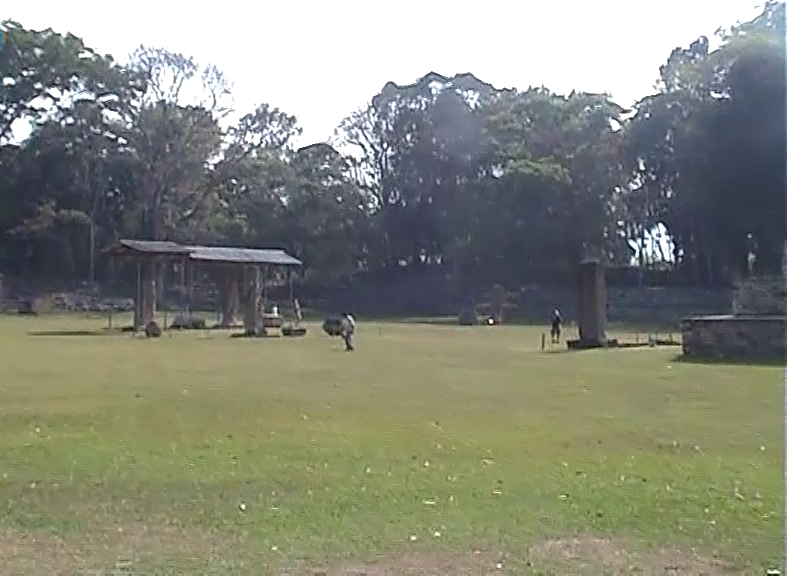 Canopied steles in the Grand Plaza
Canopied steles in the Grand Plaza
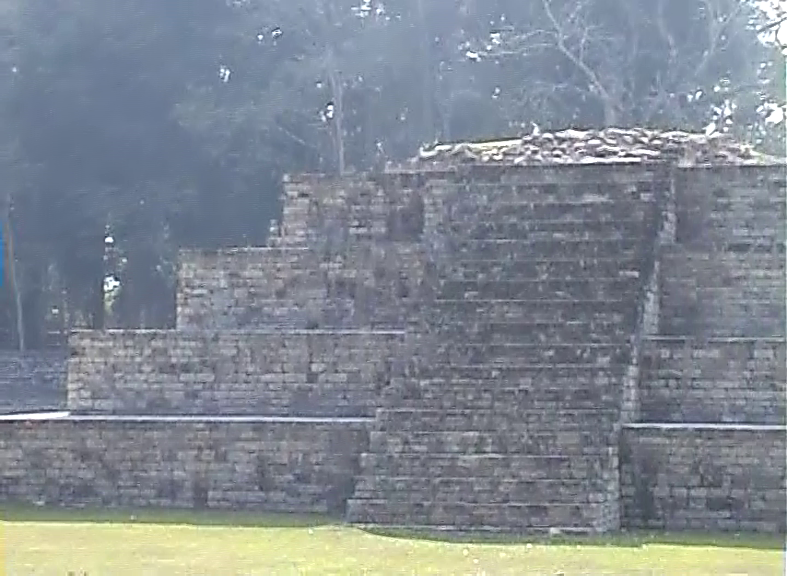 Stepped pyramid-platform in the Grand Plaza – Structure 4
Stepped pyramid-platform in the Grand Plaza – Structure 4
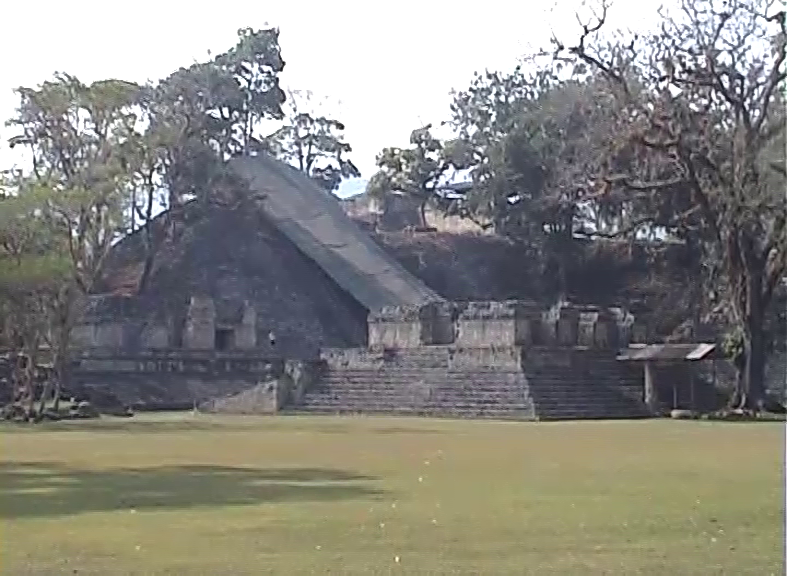 Ballcourt and the Hieroglyphic Stairway at the end of the Grand Plaza
Ballcourt and the Hieroglyphic Stairway at the end of the Grand Plaza
The Grand Plaza used to be used for different ceremonies and nowadays there are numerous stele placed there, so I actually started with my visit to the site by going from one stele to the next.
The first one on my way was Stele A from 731 CE.
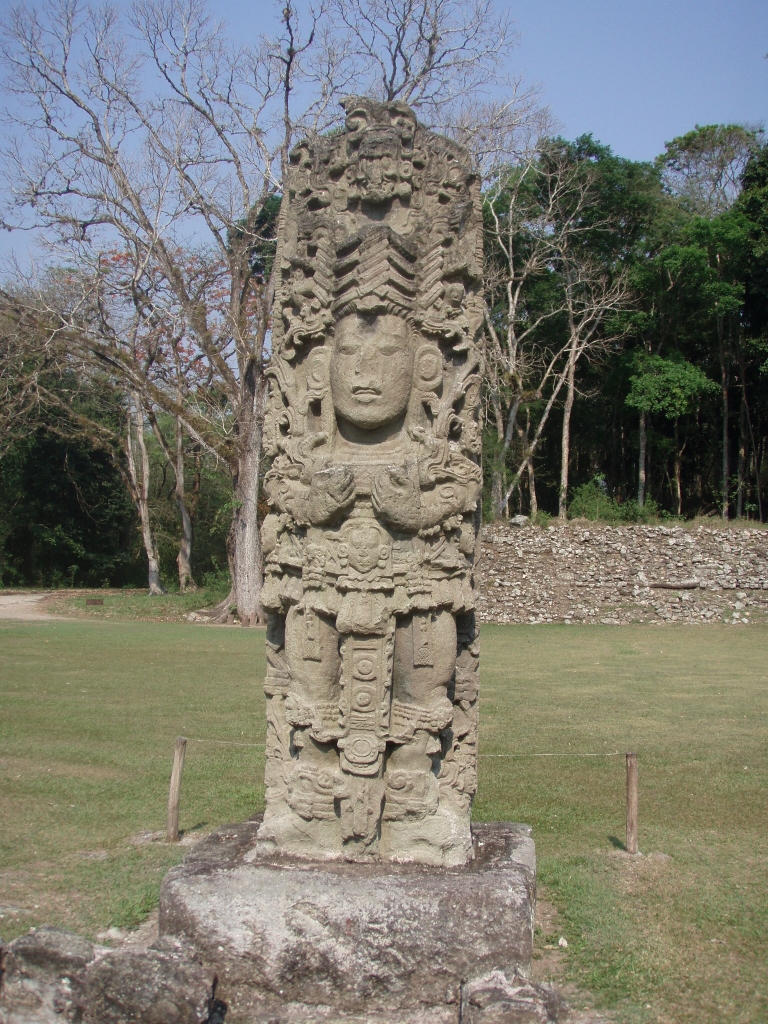 Stele A
Stele A
It shows ruler 18 Rabbit. More accurately, his name was Uaxaclajuun Ubʼaah Kʼawiil, but is obviously easier to say 18 Rabbit. So, 18 Rabbit ruled from 695 to 738 CE and he was the 13th ruler within the dynasty. According to the available data, Copán was ruled by 17 kings or lords who carried the title of ajaw, with a note that there was a pause of a dozen years between the 16th and the 17th ruler. During the reign of 18 Rabbit numerous structures were built in the city and also a large number of steles with his image were made. Stele A is precisely one of them.
In it we can see ruler 18 Rabbit holding a ceremonial bar, which is the evidence of his sovereignty, while above his head there is a death mask which in fact shows the Sun god. Also, in this stele there is a text which proclaims that Copán is one of the four large city-states in the Maya World, alongside Calakmul, Palenque and Tikal. The stele that is seen in the photo is a copy, while the original can be seen at the Sculpture Museum.
Because of the large number of structures and steles made during the reign of 18 Rabbit, he is considered to be one of the greatest rulers of Copán and certainly one of the biggest patrons of art. It was precisely his execution in 738 by the ruler of Quiriguá that created almost a vacuum in the development of Copán.
The next was Stele 4 from 726 and it also shows ruler 18 Rabbit.
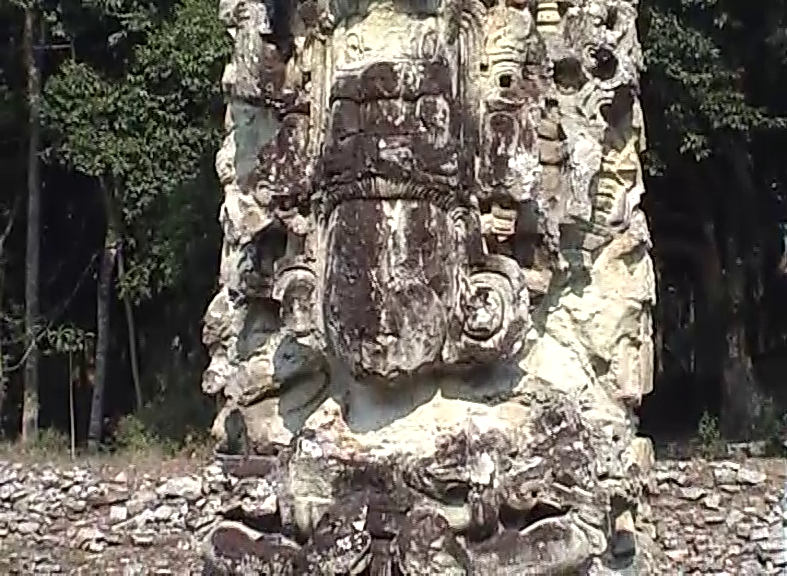 Detail of Stele 4
Detail of Stele 4
Right in front of Stele 4 there is a stone altar of an interesting round shape.
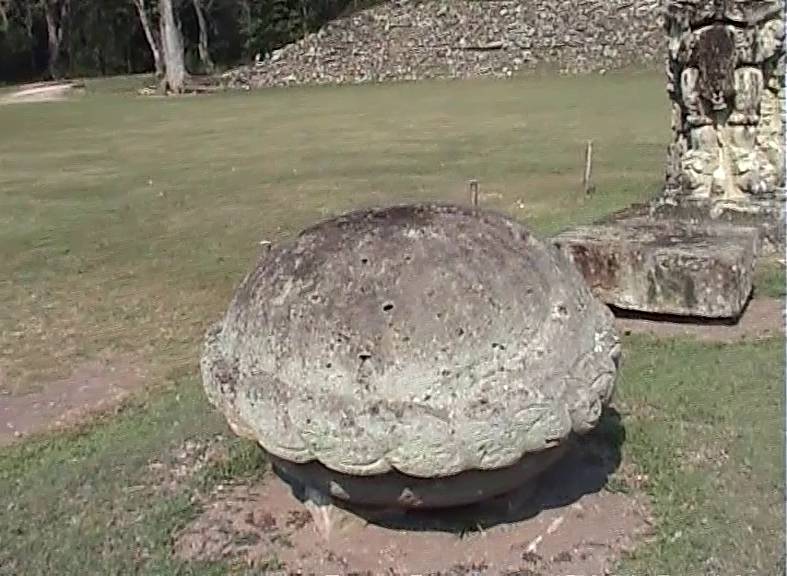 Altar in front of Stele 4
Altar in front of Stele 4
On the altar it is possible to see a groove circularly going from the top down and in the past it was thought that such grooves on stone altars were used for the blood flowing out, but this position has been abandoned and nowadays the researchers believe that it was used for the melting of some kind of resin.
Also, through the steles in Copán one can see the exceptional skill of the ancient Mayas linked to the creation of the sculpture in the round, meaning that the steles were carved on all four sides, as can be seen well in the case of the following one and this is Stele B.
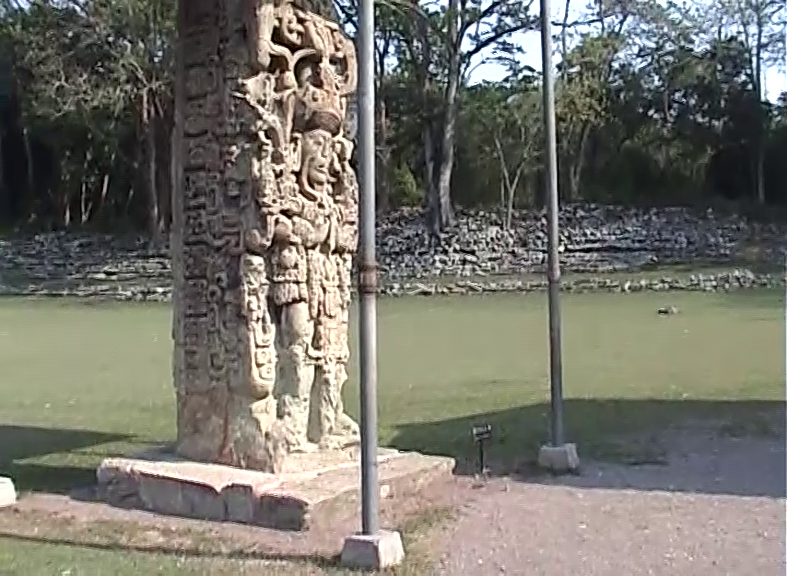 Stele B
Stele B
Stele B is from 731 and it shows ruler 18 Rabbit after his accession to the throne.
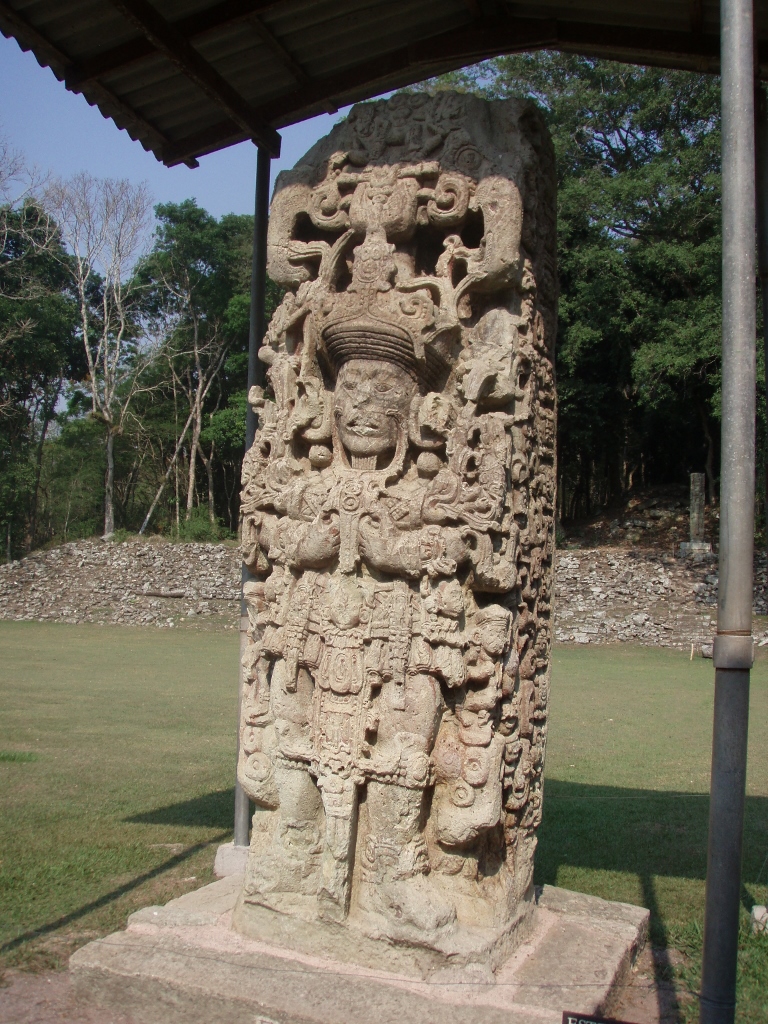 Stele B
Stele B
Then I came to one of the altars beside Stele C. This one is in the shape of a turtle, while the other one was never completed and only lies there as a thick stone slab.
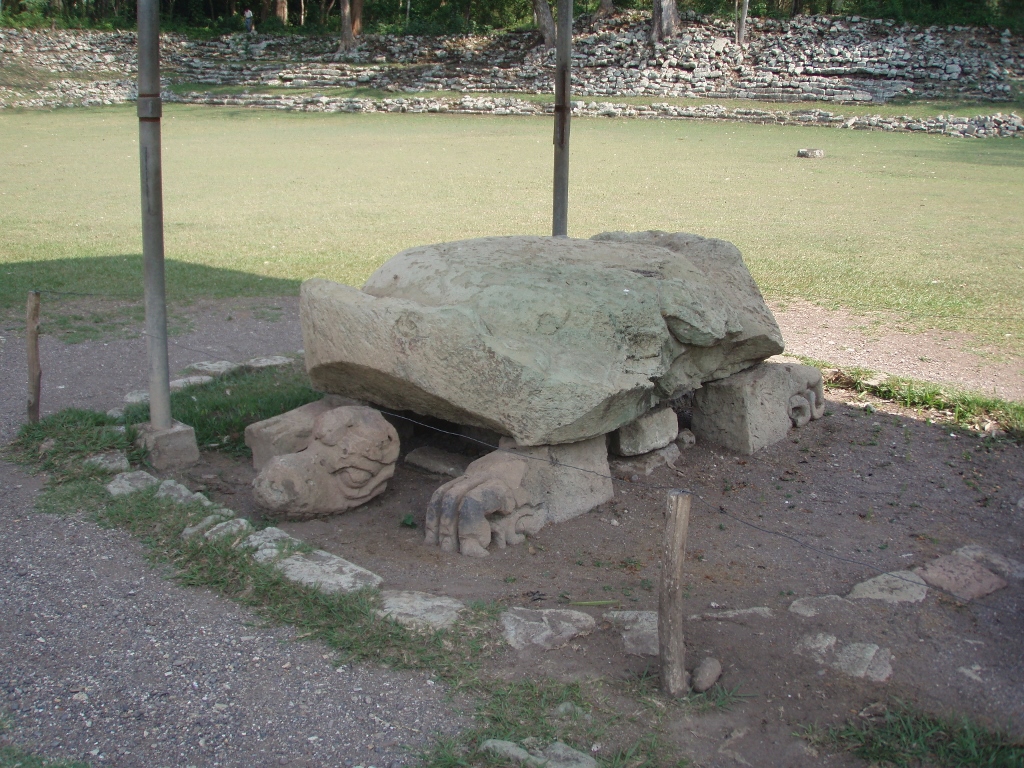 Altar in the shape of a turtle
Altar in the shape of a turtle
As for Stele C that stands between these two altars, it was made in 730 and it is particularly interesting because it has two faces (like the Roman god Janus) on two sides of the stele. On one side, there is an elderly man with beard, while on the other side there is a young, beardless man. The stele is 3.80 m tall and it still has remains of red colour. It is presumed that originally all of the steles were covered in red.
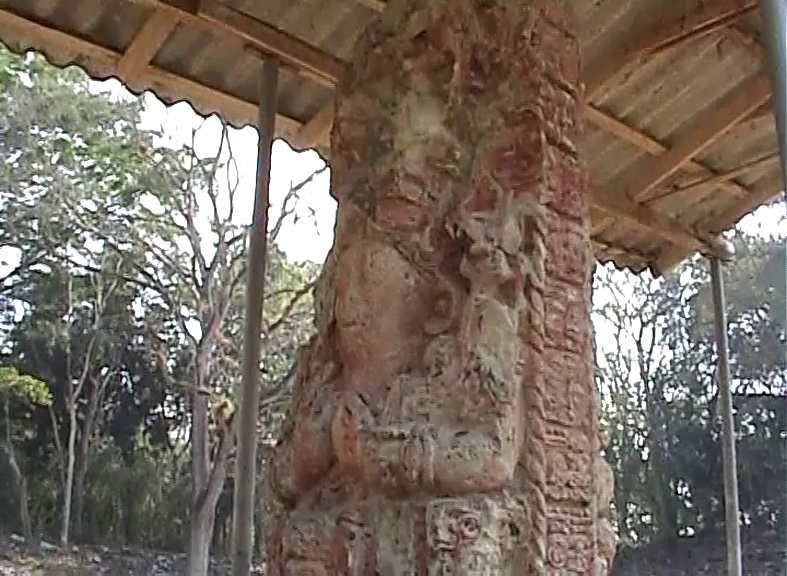 Stele C, the side with the elderly man with beard
Stele C, the side with the elderly man with beard
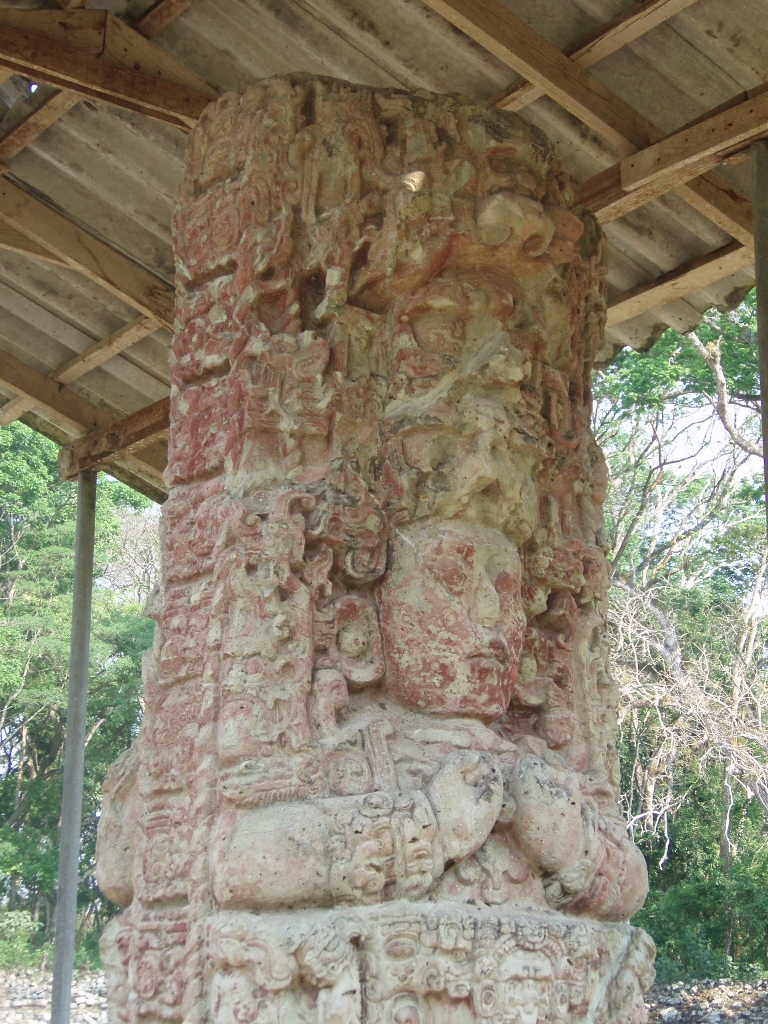 Stele C, the side with the young, beardless man
Stele C, the side with the young, beardless man
Here I also got to the north part of the Grand Plaza which is closed off by Structure 2. This is the stepped stone structure visible in the photo below which is now rather shapeless, but it is known that it was built during the reign of Chan Imix Kʼawiil, who in literature is most often called Smoke Imix or Smoke Jaguar. On the basis of the preserved texts, it has been concluded that he had the longest reign of all the kings of Copán – he ruled from 628 until 695 and was succeeded by 18 Rabbit. The researchers also believe that he was born in 612, which means that he ascended to the throne at the age of 15 and lived 83 years, which was very impressive for that time.
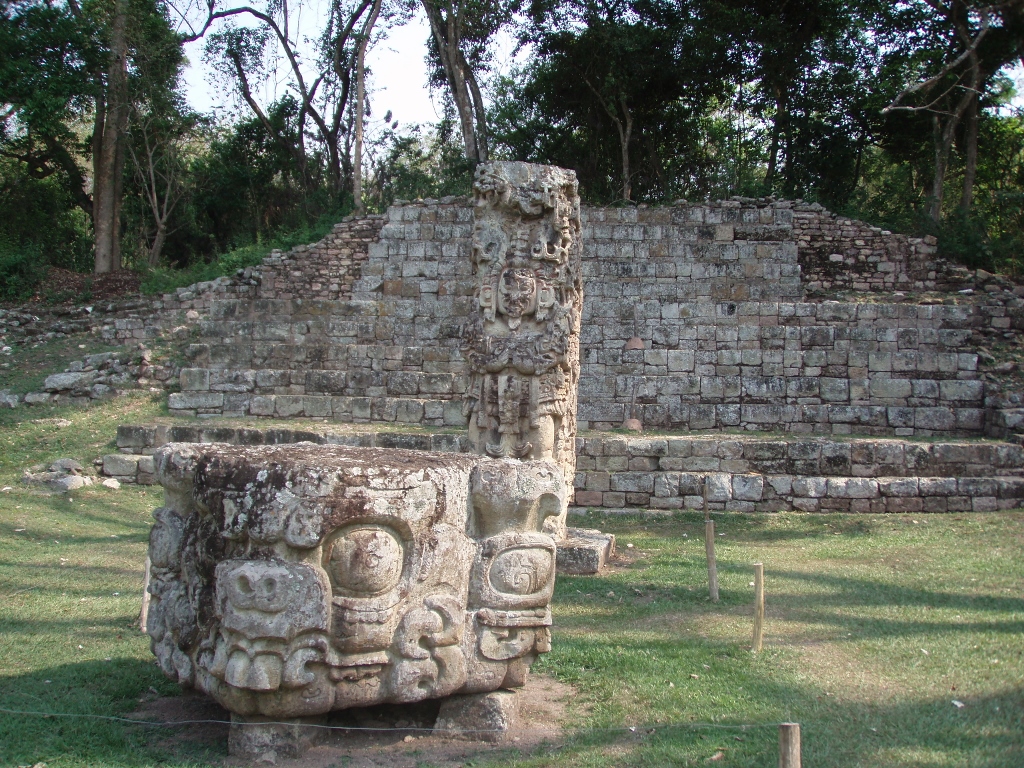 Structure 2 in the background, while in front there are Stele D and an altar depicting god Chaac
Structure 2 in the background, while in front there are Stele D and an altar depicting god Chaac
In addition to Structure 2, the photo above also shows Stele D from 736, which is presumed to show ruler 18 Rabbit again, as well as an altar that shows the formidable rain god Chaac.
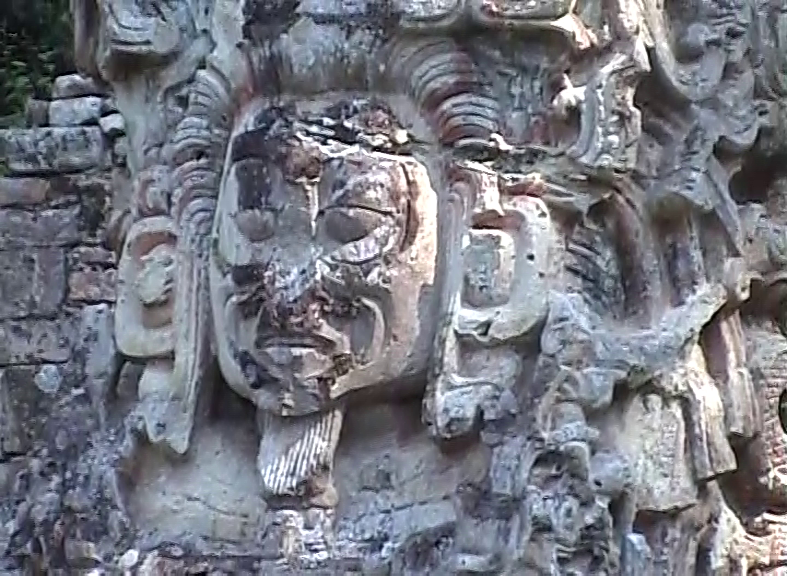 Depiction of ruler 18 Rabbit on Stele D
Depiction of ruler 18 Rabbit on Stele D
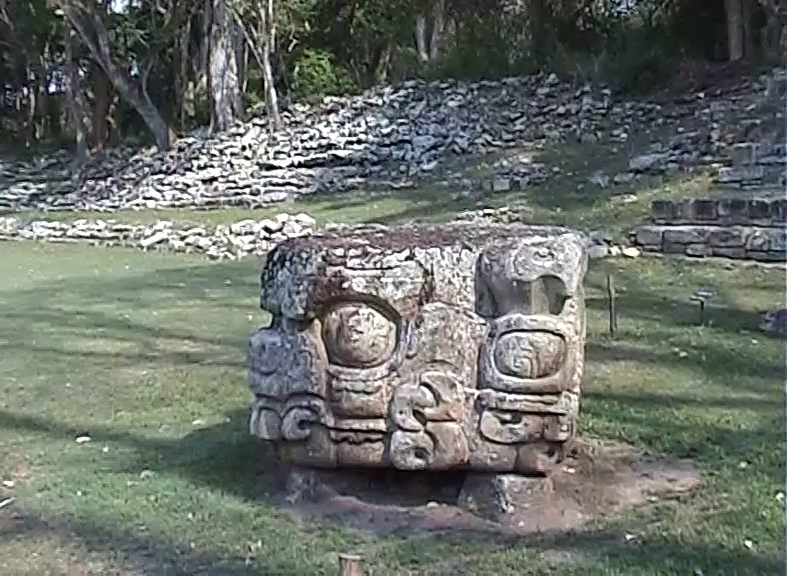 Profile of the altar with the depiction of good Chaac
Profile of the altar with the depiction of good Chaac
Then I reached Stele F from 721 showing a figure that has moustache and beard, and the altar in front of it in the shape of a two-headed monster. The following photo also shows Altar G in the shape of two serpent heads, Stele H, as well as Structure 4, that is, the pyramid at the entrance to the site of Copán.
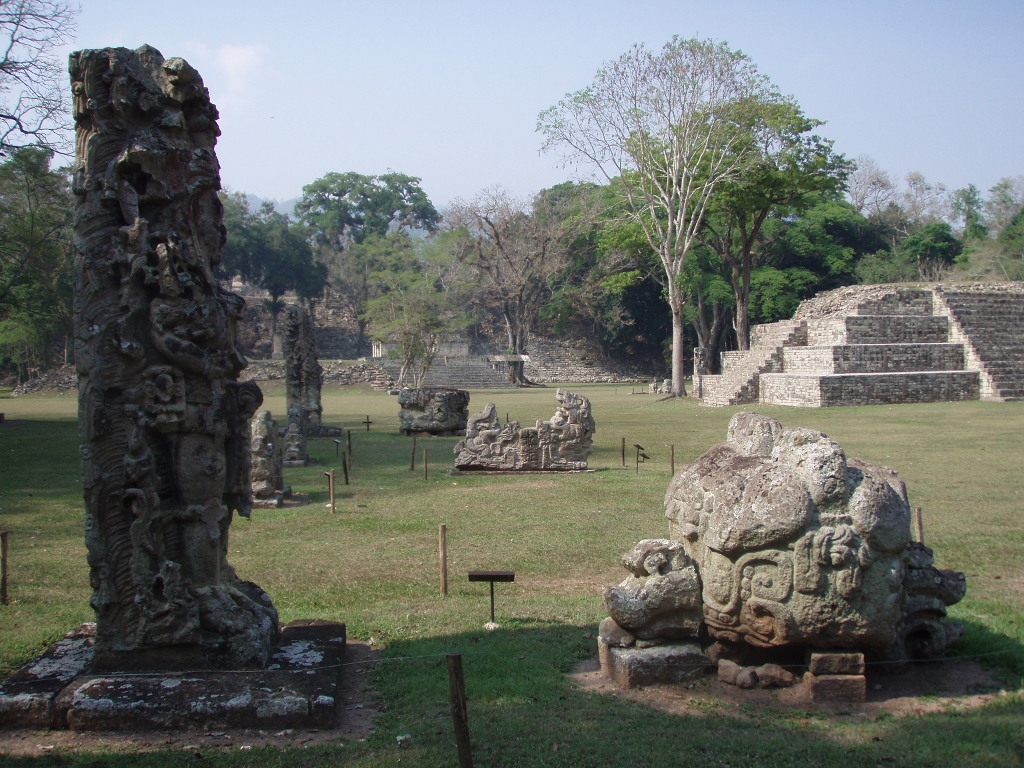 Stele F (left) with its altar, Altar G (middle) and Structure 4 (right)
Stele F (left) with its altar, Altar G (middle) and Structure 4 (right)
In this part of the Grand Plaza there are several steles and altars, one of the more interesting being Altar G in the shape of two serpent heads. As I took a photo of it from a different side in comparison to the photo above, the following photo also shows the altar in front of Stele F in the shape of a two-headed monster.
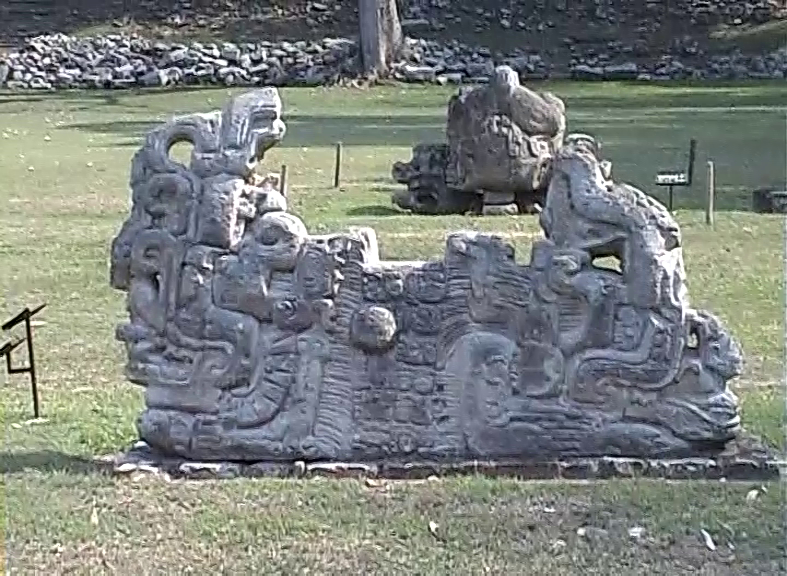 Altar G (middle) and behind it the altar in front of Stele F
Altar G (middle) and behind it the altar in front of Stele F
Here I also looked at the surroundings of the Grand Plaza, more accurately of its northeast part where there is a stepped-terraced structure. By the way, the plaza itself was originally paved, but nowadays there is only a well maintained lawn.
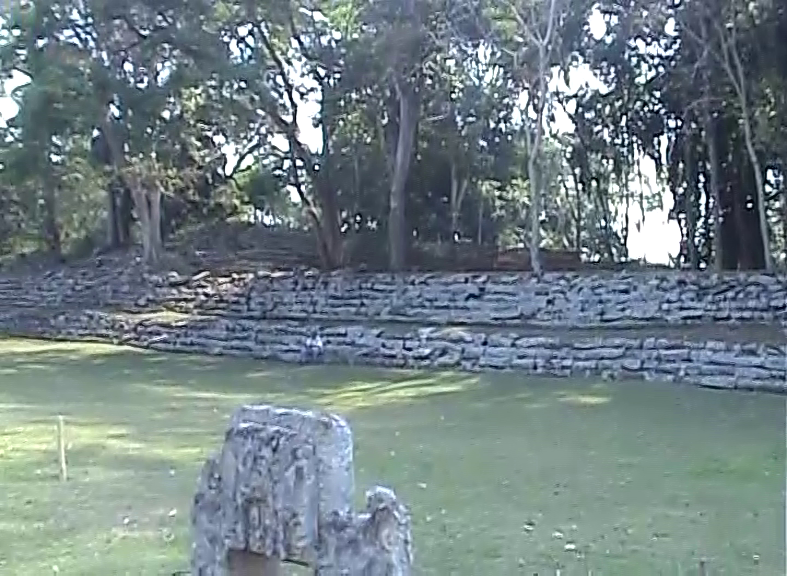 Northeast side of the Grand Plaza in Copán
Northeast side of the Grand Plaza in Copán
Stele H from 730 is also very interesting. Namely, it is the only one where the main image is shown wearing a skirt. A lot of them think that this is a woman, but judging by the other characteristics and face features, this cannot be ascertained clearly. Of course, not all the researchers agree with this, but if this supposition were true, then this would be the only depiction of a female person in Copán.
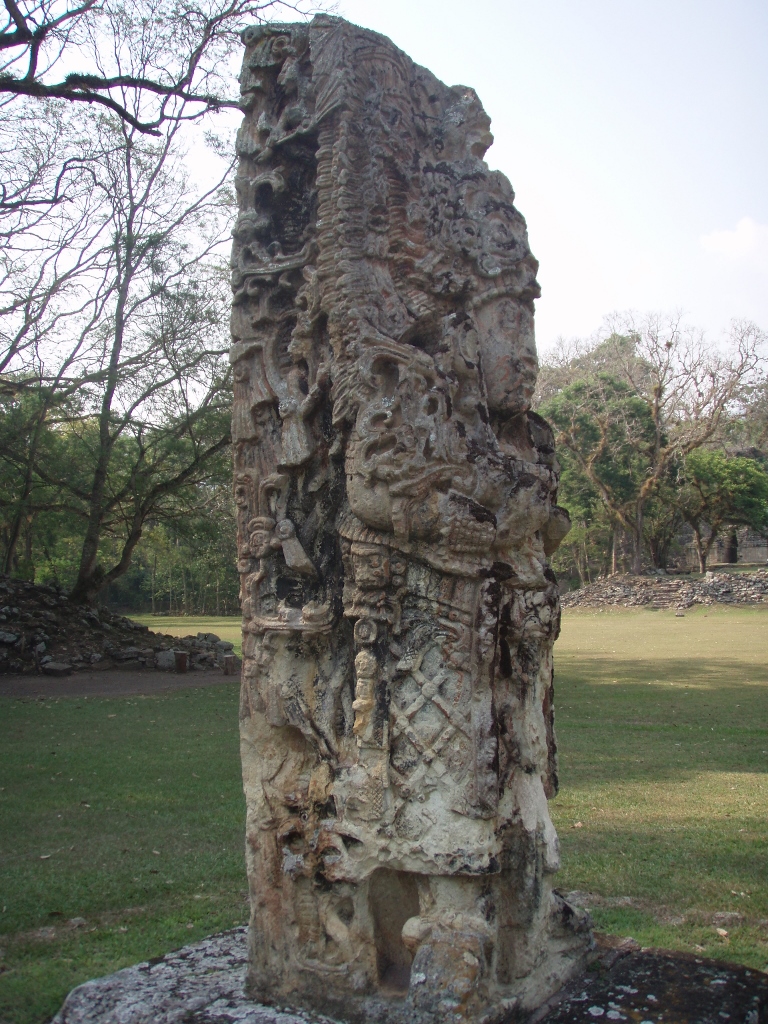 Stele H
Stele H
Since this whole stele was in the shade, I circled slowly around it filming it with my video-camera, because I knew there would not be sudden changes in light between the strongly lit sections and those being in the shade. I have decided to include a short video clip here dealing with Stele H. While showing how truly impressively and opulently these steles were decorated, it also illustrates how much I talked while doing the sightseeing and filming around. Let there be no mistake, I am a translator/interpreter and not a historian of art or an archaeologist specialised in the Maya civilisation, so I don’t know all the data by heart. What I usually do when visiting different sites is that I first read the information about the given object in the guidebook (here I had my secondary, more localised guidebook, while the “main” one was forgotten at the internet-café) and then I repeat this while filming. Thanks to that I have a lot of preserved information and memories which I use when writing these stories 13-14 years later.
Here is once again Stele H with its altar and Structure 4.
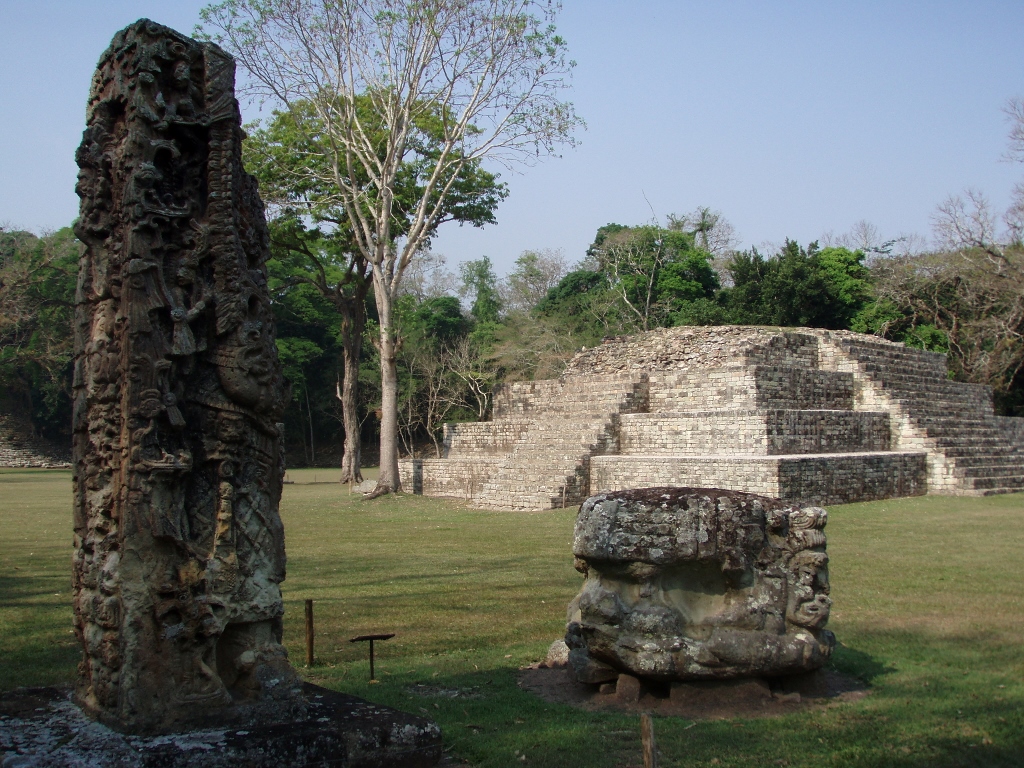 Details from the Grand Plaza
Details from the Grand Plaza
Here I also finished with the visit to the north part of the Grand Plaza that contains the steles and so I headed in the direction of the Ballcourt. From there I looked back once again at the Grand Plaza and was impressed not only by the plaza, but also by fact that apart from the guards and myself, there was nobody else around.
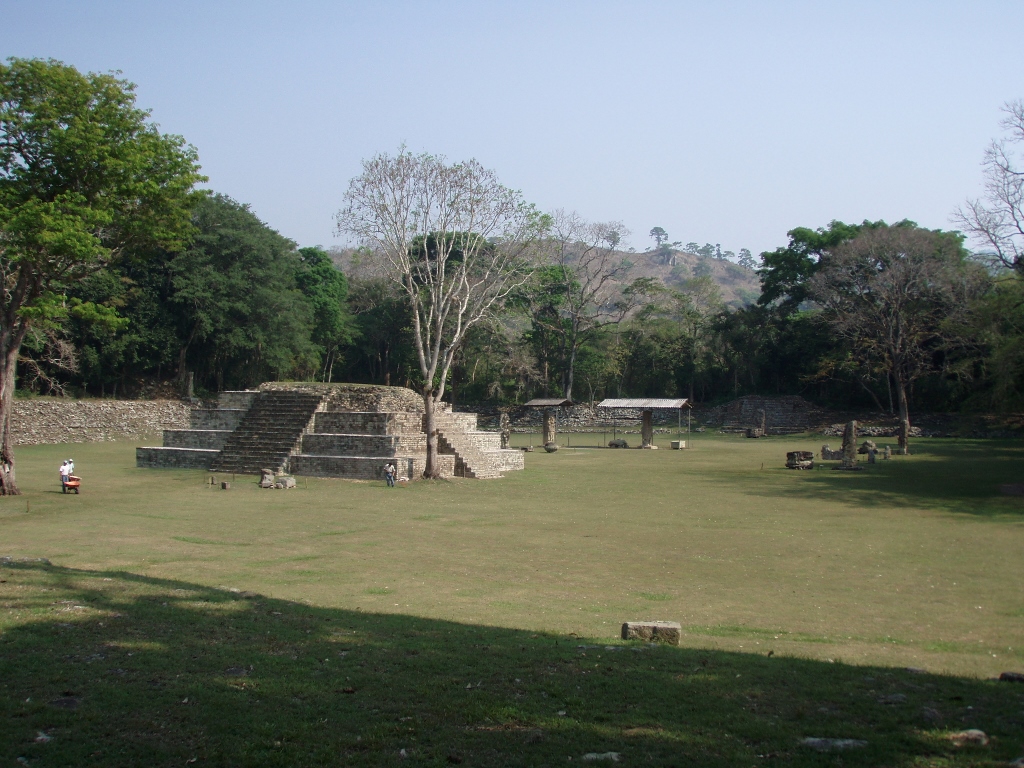 Grand Plaza in Copán
Grand Plaza in Copán
The photo above was made while I was standing on a slightly elevated structure from which I could see well not only the Grand Plaza, but also a couple of steles made by ruler Smoke Imix (628- 695). These are Stele 2 and Stele 3, while in between there is Altar L. Both of these steles were made in 652 CE.
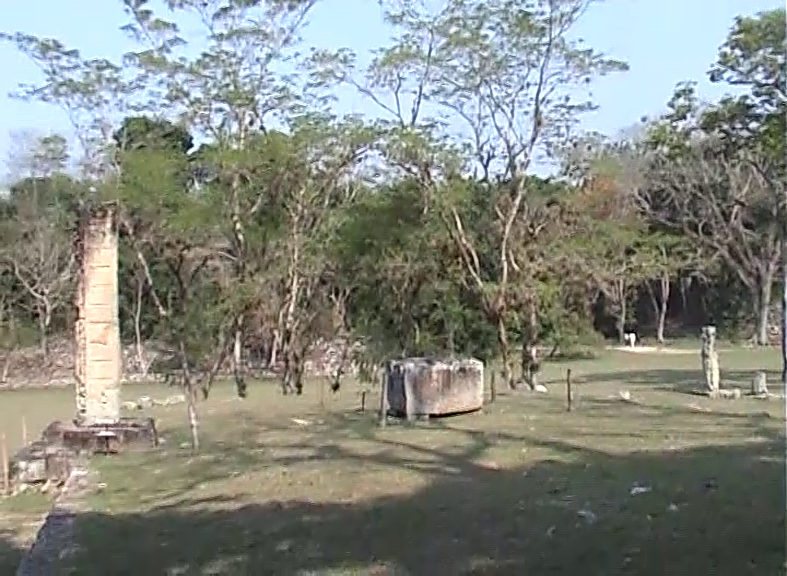 Stele 2, Altar L and a little farther Stele 3
Stele 2, Altar L and a little farther Stele 3
From this elevation I could also see very well the lateral side of Structure 10 that constitutes the east part of the Ballcourt. This is perhaps the finest example that shows how the ancient Maya made their corbel arch or rather the corbel vault, as the case may be, which they regularly used in their architecture since obviously they did not know how to make a proper arch.
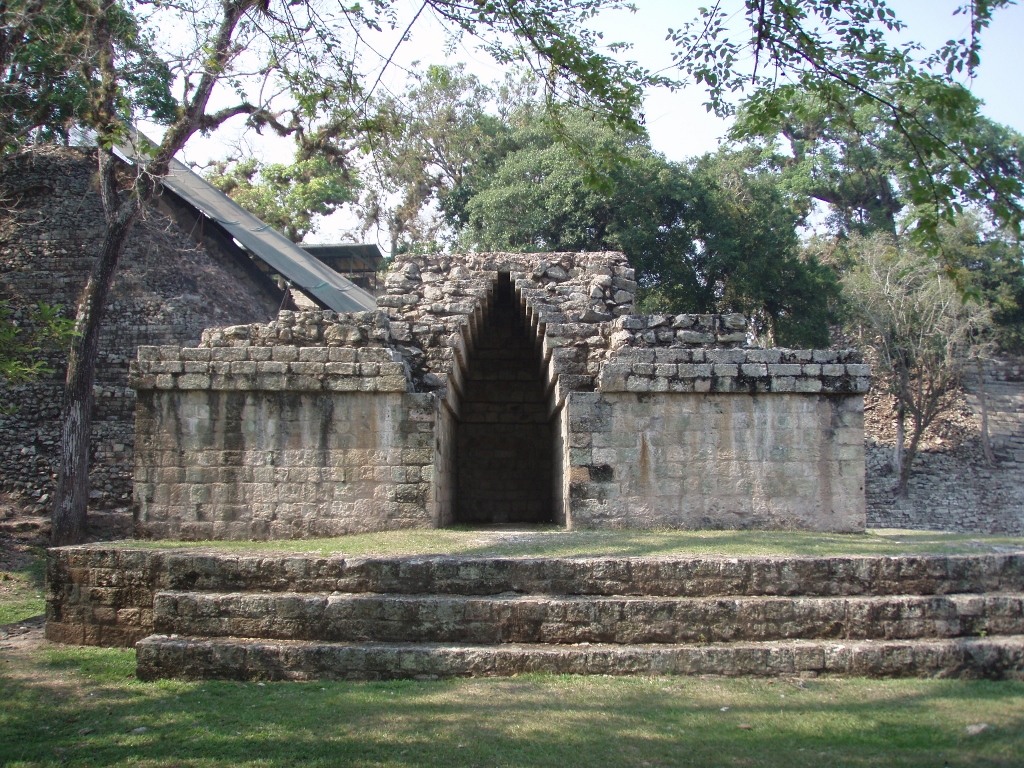 Structure 10 and its interior vault
Structure 10 and its interior vault
From here there was also a wonderful view at the Ballcourt and Structure 9 that constitutes the west side of the ballcourt, while a little farther away it was possible to see the canopied Stele N and high Structure 11, also called the Temple of the Inscriptions.
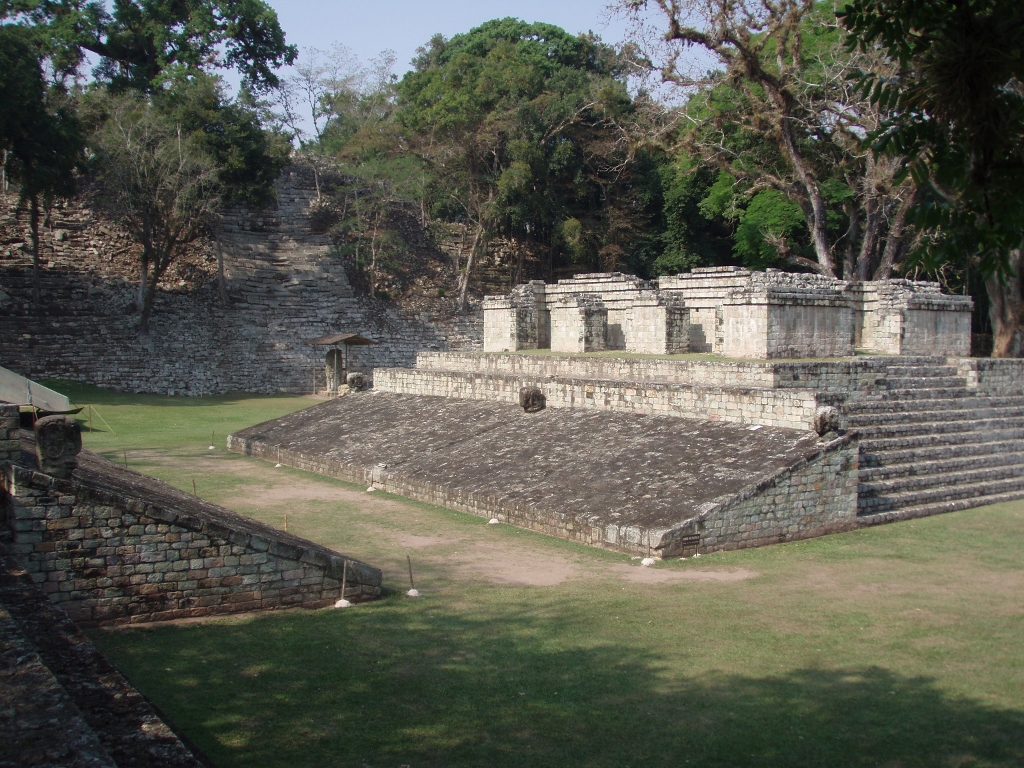 Ballcourt
Ballcourt
The Ballcourt has the classic and easily recognisable form in the shape of letter I. This is the second largest ballcourt in Central America (the largest one being in Chichén Itzá). The ballcourt was built in 738 at the very end of the reign of 18 Rabbit and it was constructed on the top of two smaller ballcourts, one of which is from the 6th century and the other from the beginning of the 8th century.
If you look a little more closely, on the top of the western slope of the Ballcourt there are stone macaw heads. Macaws have been very popular in all of Latin America because of their picturesque brightly-coloured feathers and they were also important for the mythology of the ancient Mayas. The following photo shows a little better one of the stone macaw heads that decorates the middle part of the Ballcourt’ east side.
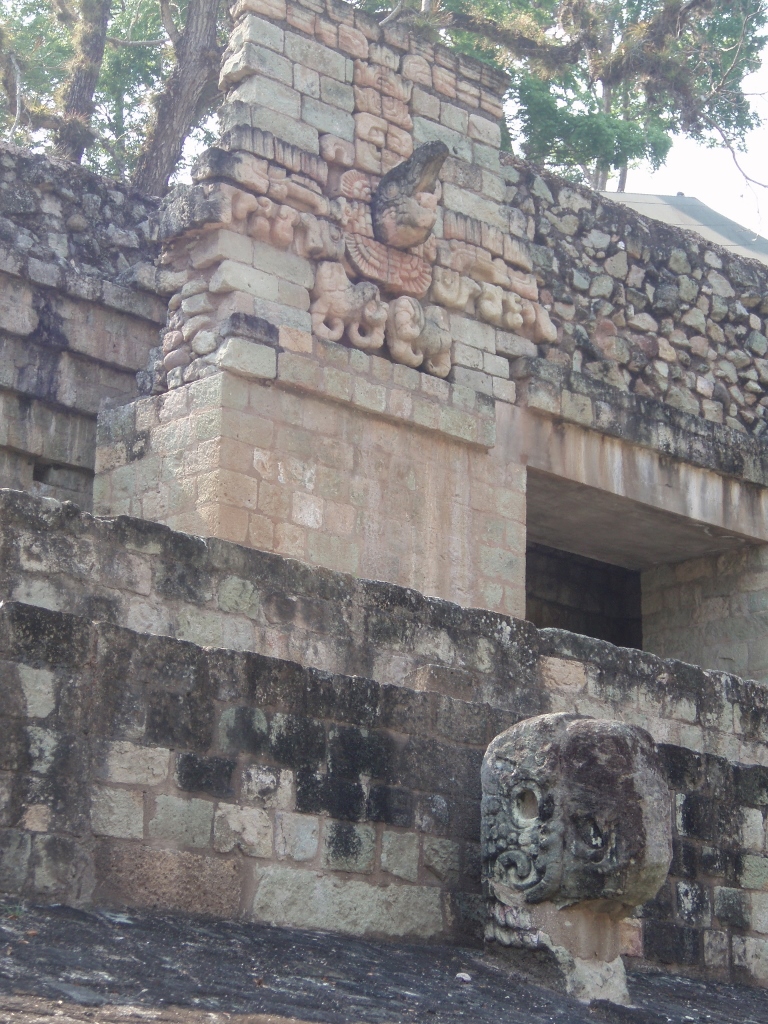 Decorations on the east side of the Ballcourt (the macaw head is below and to the right)
Decorations on the east side of the Ballcourt (the macaw head is below and to the right)
Right next to the Ballcourt there is the Hieroglyphic Stairway (Escalinata Jeroglifica). This is one of the most famous monuments from Copán that was made during the reign of Kʼakʼ Yipyaj Chan Kʼawiil for whom most often another, much simpler name is used – Smoke Shell or Smoke Squirrel. He ruled from 749 until 763.
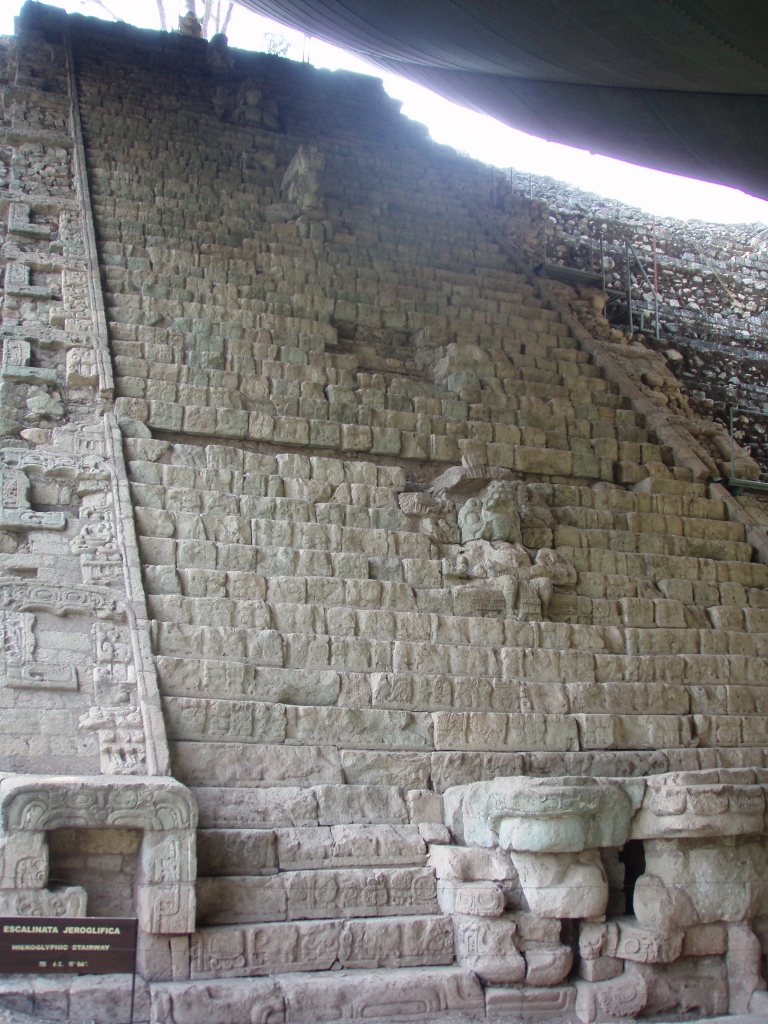 Hieroglyphic Stairway
Hieroglyphic Stairway